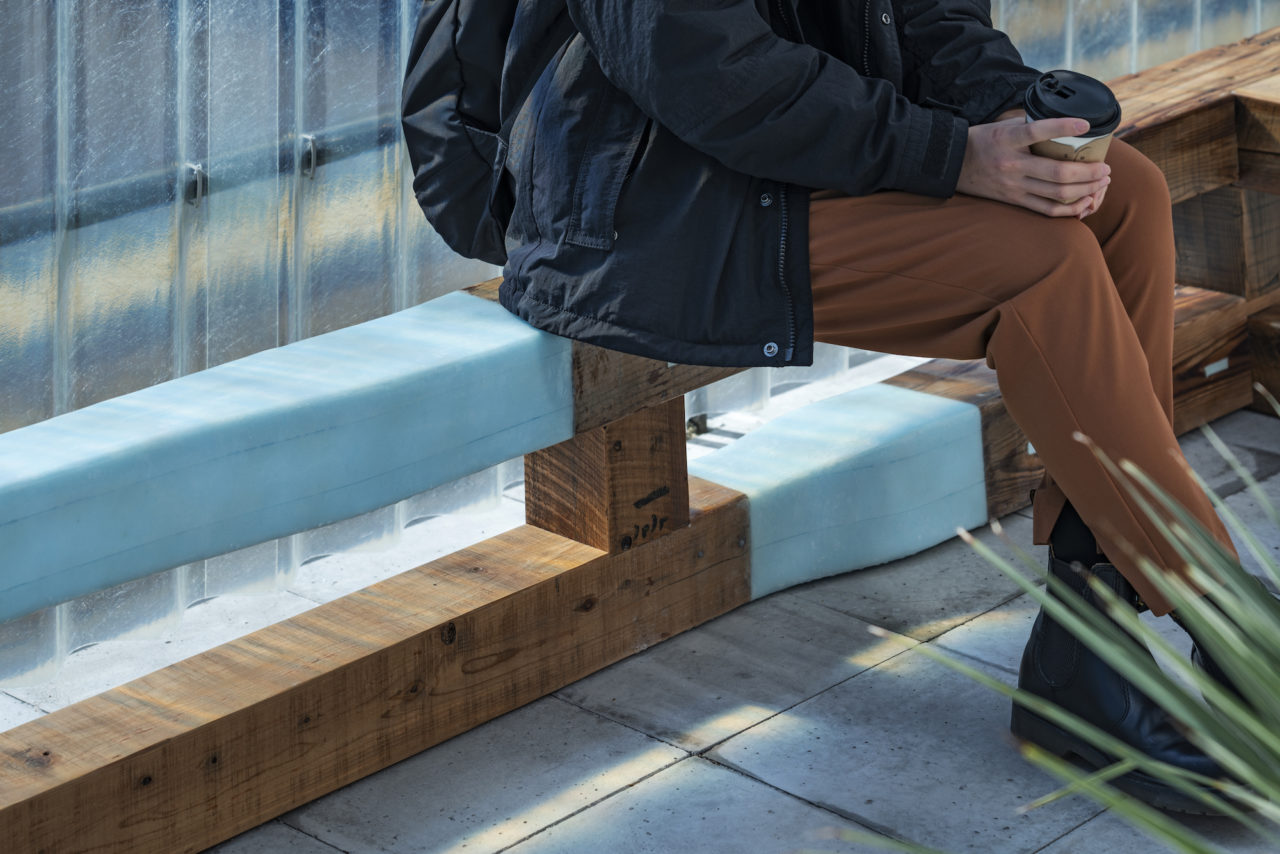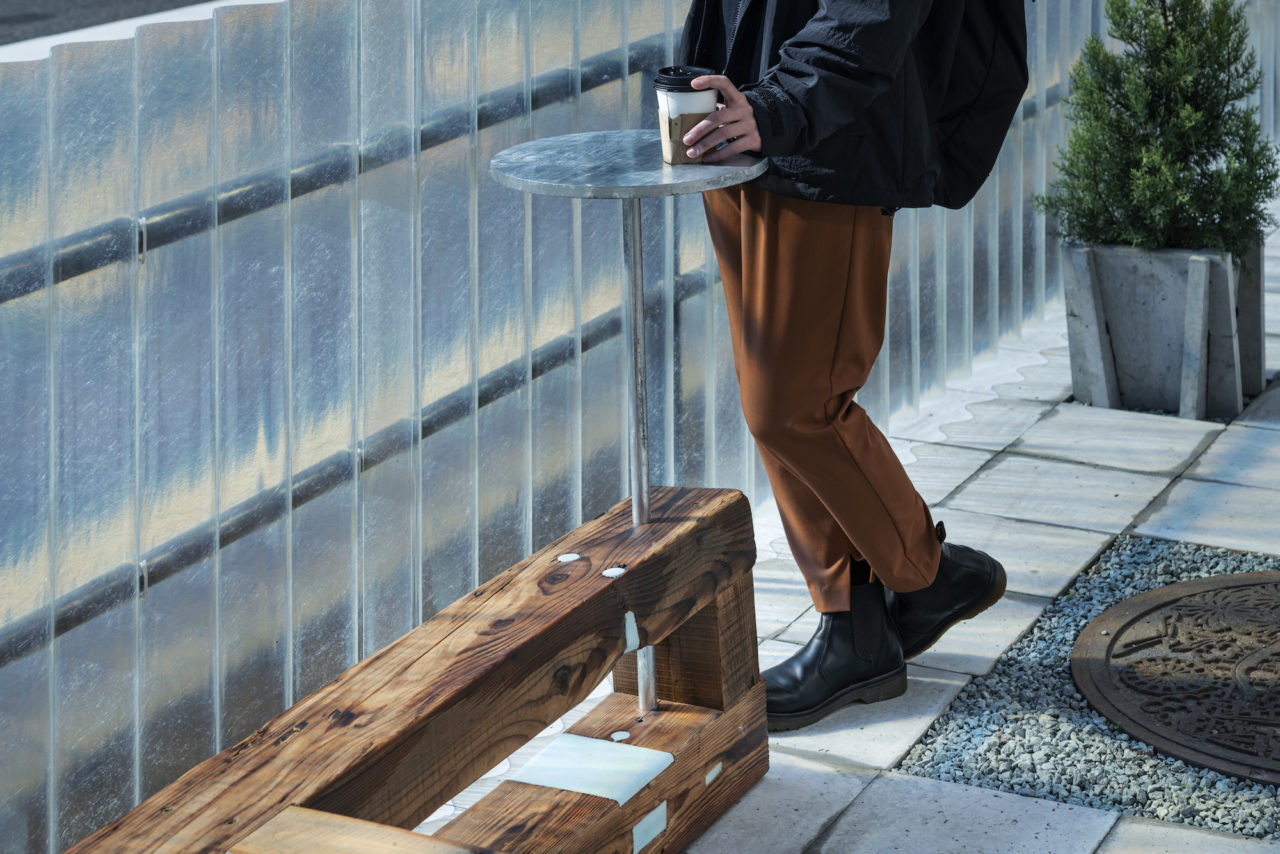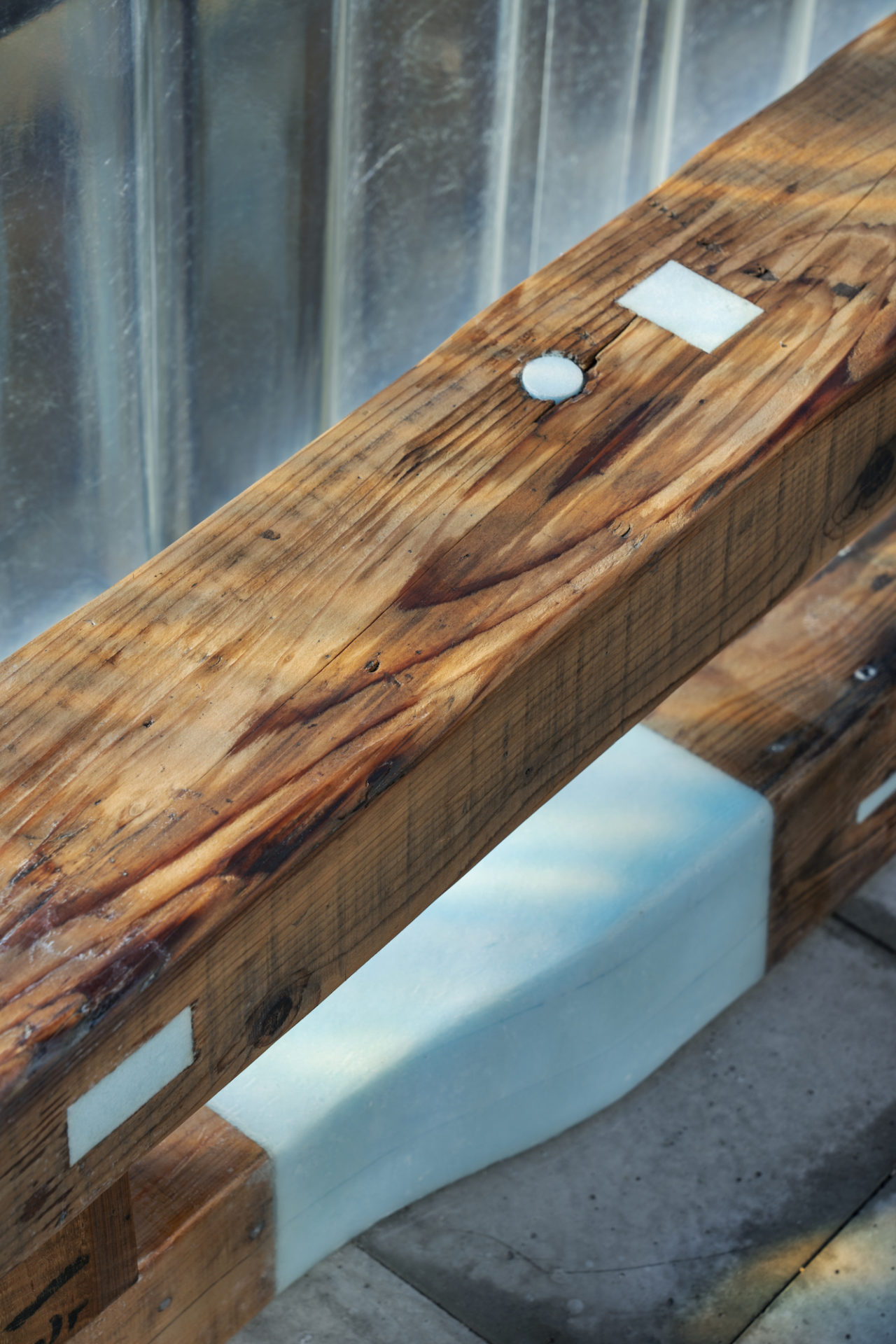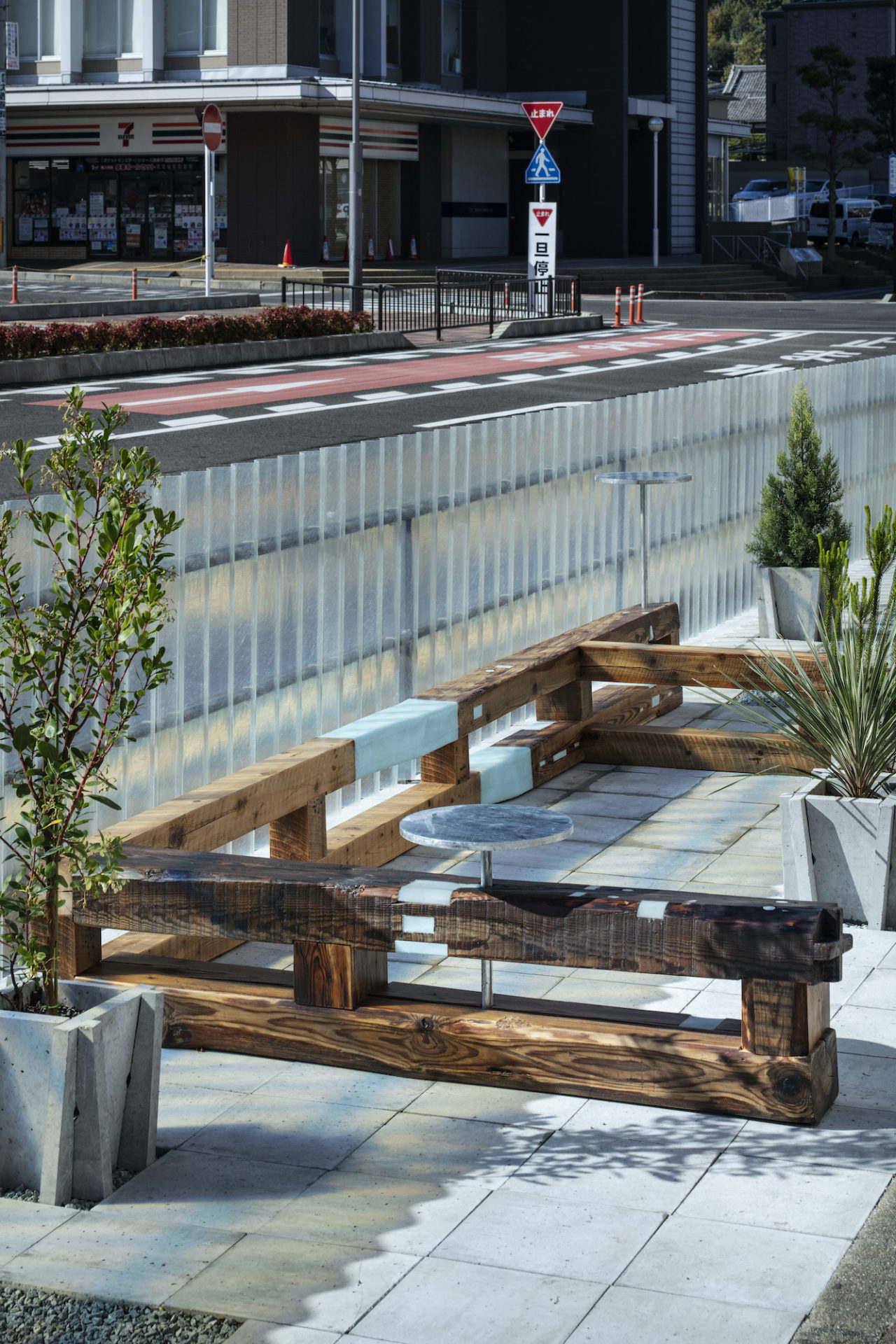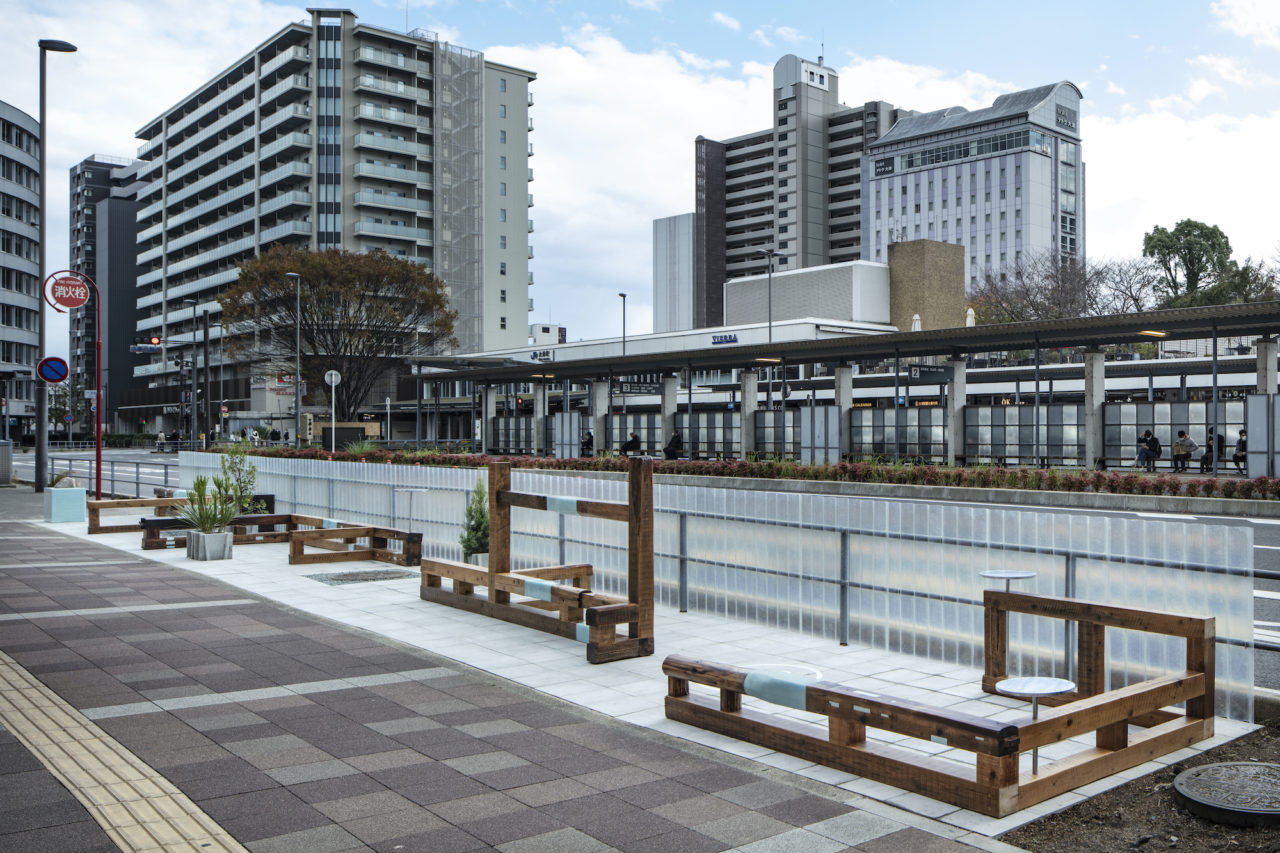滋賀県大津市の駅前にストリートファニチャーを設置する計画である。計画地付近の建物には、古い家屋を解体した時に出た柱や梁などの材料がかなりの数放置してあり、材料は廃棄を待つだけの状態となっていた。今回の計画の中でそれらの古材に新たな価値を与え、街の中で利用されるものに生まれ変わらせたいと考えた。
長年に渡り建築の一部として役割を全うした古材は、割れ・反り・ねじれなどにより人工的には再現困難な様相となっていく。新材とはかけ離れた独特な魅力を放つ一方で、古材を製作に活用するとなると大変あつかいにくい。加工・接合・固定はもちろん、表面の仕上がりの品質を求めることも困難である。それゆえ古材をいざ活用しようとしても、ある程度形の整った材や、太さの近い材を選びとって使いたくなる。不揃いで変形した古材は”使いたくても使いにくい材”であるとも言える。そうした一長一短な古材の個性を、可能な限りポジティブに活かす方法を模索した。
断面形状の異なる古材同士を組み合わせていくと、接合部分に段差ができてしまう。家具としての性能を確保するため、段差を解消するような接合方法が求められた。建築の断熱材として開発されたスタイロフォームは、その造形のしやすさから彫刻の型や建築模型など様々な場面で利用されている材料である。スタイロフォームをジョイントとすることで、古材どうしをシームレスに連続させることを考えた。スタイロフォームと古材を跨いでFRPを巻くことで、ジョイント部分の表面強度と接合強度を持たせた。こうして古材どうしを繋ぎ合わせることで、あり合わせの材料から製作に必要な長さ・形状の材料を造り出していく。古材に元からあるほぞ穴やボルト穴の跡など、家具として使用する際に支障となる凹凸はスタイロフォームで埋め、単体の中でも段差を解消していった。
最終的なスタイロフォームの形状は古材どうしの断面形状から自動的に決定される。しかし、実際は施工者の加減によって曲線の具合などは変化するため、作り終えるまで完成形が予測しきれない。製作が進むにつれ、より完成形が予測できない=より複雑に変形している材料どうしを組み合わせてみたいという気持ちが高まり、結果として変形した材料が多く組み込まれることとなった。
こうしてできた部材を用いて、ベンチやテーブルとして利用できるストリートファニチャーを製作した。古材の個性がスタイロフォームの形状にも現れ、家具全体を特徴づける要素となった。製作方法の工夫によって、単体としては魅力がない材や、他部材と組み合わせることが難しい材も積極的に使用することができる。本プロジェクトではその可能性を感じた。
Street Furniture alongside Otsu Station
This project is for installing street furniture in front of a train station in Otsu City, Shiga Prefecture. In the vicinity of the project site, many old posts and beam materials were left behind from demolishing old houses, and the materials were waiting to be discarded. In this project, we wanted to give new value to these old materials and revitalize them into something that would be utilized in the community.
After fulfilling their role as a part of the buildings for many years, old lumbers become cracked, warped, and twisted in ways that are difficult to reproduce artificially. While it has a unique charm far removed from new wood, old wood is tough to handle when used in production. It is challenging to process, join, and fix old wood, and it is also challenging to obtain a high-quality surface finish. Therefore, selecting wood of a certain degree of shape and similar thickness is tempting when using old lumber. However, it can be said that unevenly shaped and deformed old lumber is “challenging even if you want to use it. Therefore, we sought a way to make the best use of the unique characteristics of old lumber in as positive a way as possible.
When old lumber with different cross-sectional shapes is combined, there are steps at the joints. To ensure the functionality of the furniture, a joining method was sought that would eliminate the steps. Styrofoam, developed as a heat insulator for construction, is a material that has been used in various situations, such as sculpture molds and architectural models, due to its ease of formability. The idea was to create a seamless continuity between old timbers by using Styrofoam as a joint. The joints were given surface and collective strength by wrapping FRP across the Styrofoam and the old wood. By joining the old timbers, materials of the required length and shape were created from the available materials. The unevenness of the old timbers, such as the marks of mortise holes and bolt holes, which would be an obstacle to use as furniture, were filled in with Styrofoam to eliminate the difference in level within a single piece of furniture. The final shape of the Styrofoam was determined from the cross-sectional shapes of the old lumber. Nevertheless, the curvature of the form varies depending on the builder, so the final figures can only be predicted once the work is completed. As fabrication progressed, the desire to combine materials with more unpredictable shapes (i.e., more complex deformations) increased, and as a result, many deformed materials were incorporated.
The result is a street furniture piece that can be used as a bench or table—expressed wood individualities in the shape of Styrofoam, which became a characteristic element of the furniture. Furthermore, through the ingenuity of the production method, it is possible to actively use materials that could be more attractive and easier to combine with other materials. In this project, we felt this possibility.
Client_Otsuekimae Shopping Street Promotion Association (大津駅前商店街振興組合)
Design and Fabrication_TANK
Location_Otsu-shi, Shiga-ken
Photography_Kenta Hasegawa
2021.11-2022.1
